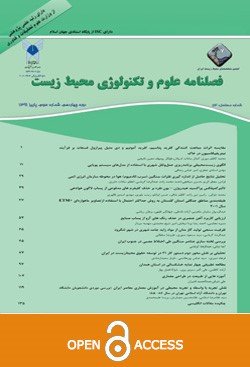اندرکنش نانورس و آلاینده فلزی مس در پروژههای ژئوتکنیک زیستمحیطی
الموضوعات :وحیدرضا اوحدی 1 , محمد امیری 2
1 - استاد گروه عمران، دانشگاه بوعلی سینا، دانشکده فنی، همدان
2 - دانشجوی دکتری مهندسی عمران، دانشگاه بوعلی سینا، دانشکده فنی، همدان*(مسئول مکاتبات).
الکلمات المفتاحية: نانورس, کربنات, فلز سنگین مس, ظرفیت بافرینگ,
ملخص المقالة :
هدف از بررسی مواد در مقیاس نانو، یافتن طبقه جدیدی از مصالح با عملکردهای نوین است، که آن ها را می توان به عنوان مصالحی با عملکرد ویژه و چندمنظوره بیان نمود. با توجه به تحقیقات وسیعی که در سالهای اخیر در موضوع اندرکنش خاک و آلودگی صورت گرفته است در زمینه فرایند اندرکنش آلایندههای فلز سنگین و نانورسها تحقیقات قابلتوجهی انجام نشده است. آلاینده فلز سنگین مس، به عنوان یکی از آلاینده های فلز سنگین متداول در پروژه های ژئوتکنیک زیست محیطی شناخته شده است. بر این اساس هدف این پژوهش مطالعه رفتار ژئوتکنیک زیست محیطی نانورس ها و نانورس های اصلاحشده با کربنات از نظر قابلیت جذب آلاینده فلز سنگین مس بوده است. برای دستیابی به این هدف، با انجام یک سری آزمایش های ژئوتکنیک زیستمحیطی، فرایند اندرکنش نانورس و آلاینده فلز مس مطالعه شده است. بررسی ظرفیت بافرینگ و میزان نگه داری فلز مس به وسیله نانورس های اصلاحشده در حضور کربنات نشان میدهد که بخش قابل توجهی از ظرفیت بافرینگ و قابلیت خاک در نگه داری آلاینده، ناشی از حضور کربنات است. نتایج تحقیق حاضر بیان گر آن است که در نمونه های بنتونیت، کائولینیت و چهار نانورس کلوزایت، ترتیب قابلیت نگه داری آلودگی به صورت ذیل بوده است: Bentonite > Cloisite®Na+ > Kaolinite > Cloisite®30B > Cloisite®20A > Cloisite®15A لیکن با افزایش درصد کربنات ترتیب قابلیت نگه داری آلاینده توسط نمونه های رسی فوق تغییر می کند. هنگامی که نمونه های نانورس با 8% کربنات اصلاح می شوند، ترتیب قابلیت نگه داری آلودگی فلز سنگین مس توسط نمونه ها به صورت ذیل بوده است:
- Bradbury, M. H, Baeyens; B., (2009). "Sorption modelling on illite Part I: Titration measurements and the sorption of Ni, Co, Eu and Sn", Geochimica et Cosmochimica Acta 73; pp. 990–1003.
- Cruz-Guzmán, M., Celis, M. C. Hermosín, W. C. Koskinen, E. A. Nater and J. Cornejo., (2006). "Heavy Metal Adsorption by Montmorillonites Modified with Natural Organic Cations", Published in Soil Sci Soc Am J 70: pp. 215-221.
- Lines, M. G., (2008). "Nanomaterials for practical functional uses", Journal of Alloys and Compounds 449, pp. 242–245.
- Tiller, K.G., (1996). "Soil contamination issues: past, present and future, a personal perspective." In: Naidu, R., Kookana, R.S., Oliver, D.P., Rogers, S., McLaughlin, M. J. (Eds.). Contaminants and the Soil Environment in the Australasia-Pacific Region. Kluwer, Dordrecht, pp. 1–27.
- Yong, R. N. and Phadangchewit, Y., (1993). "pH Influence on Selectivity and Retention of Heavy Metals in Some Clay Soils," Can. Geotech. J., 30, pp. 821-833.
- Krishna B. G. and Gupta, S. S., (2008). "Adsorption of a few heavy metals on natural and modified kaolinite and montmorillonite: A review", Advances in Colloid and Interface Science 140, pp. 114–131.
- Ouhadi, V.R., and Amiri, M., (2008). "Geo-Environmetal behaviour of nano-clays in interaction with heavy metal contaminants", Proceedings of the fourth Conference on Nano-Technology, Razi University, Kermanshah.
- Ouhadi. V.R., Yong. R.N., (2003). "The role of clay fractions of marly soils on their post Stabilization failure", Engineering Geology 70, pp. 365–375.
- Yong, R. N. and Warkentin, B. P. and Phadangchewit, Y. and Galvez, R., (1990). "Buffer capacity and lead retention in some clay minerals". Water, Air, Soil, Pollution, J., 53, pp. 53-67.
- Luckham, P. F. and Rossi, S., (1999). "The colloidal and rheological properties of bentonite suspensions", Adv. Colloids Interface Sci. 82, pp. 43-92.
- Günister, E. and İşçi, S. and Alemdar, A. and Güngör, N., (2004). "The modification of rheologic properties of clays with. PVA effect", Mater. Sci. 27, pp. 101–106.
- Sevim, İ. and Seniha, F. G., (2005). "Investigation of rheological and colloidal properties of bentonitic clay dispersion in the presence of a cationic surfactant", Progress in Organic Coatings. 54 (1), pp. 28-33.
- Hesse, P. R., (1971), "A textbook of soil chemical analysis", William Clowes and Sons, 519p.
- Yong, R. N., (2000). "Geoenvironmental engineering, contaminated soils, pollutant fate and mitigation", CRC Press.
- Handershot, W. H., and Duquette, M., (1986). "A simple barium chloride method for determining cation exchange capacity and exchangeable cations", Soil Sci. Soc. Am. J. 50, pp. 605–608.


